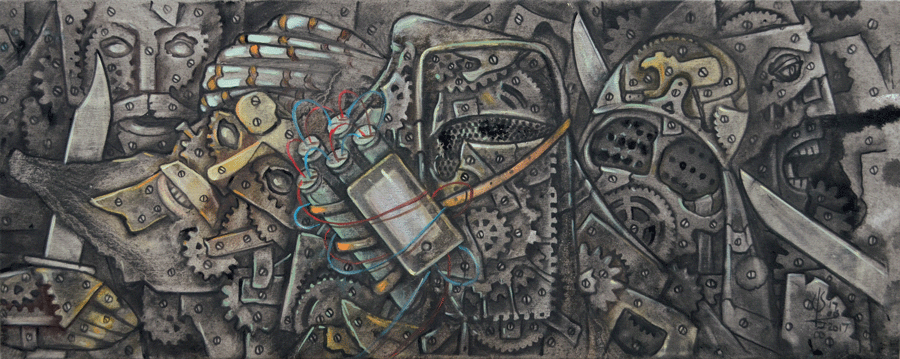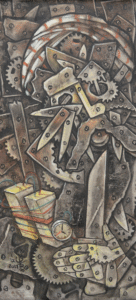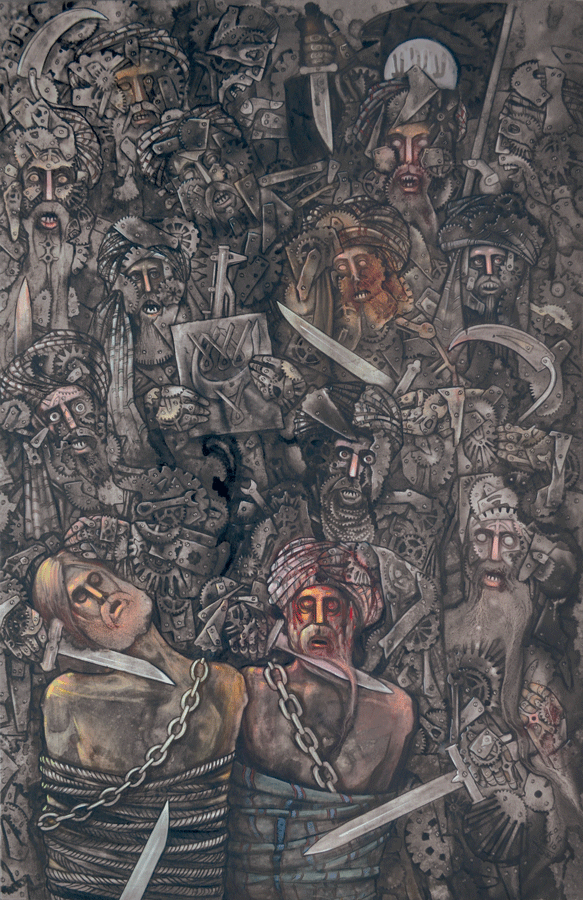Where Angels Fear to Tread
By Nusrat Khawaja | Art | Published 7 years ago

Enter Armageddon. Here is a world where joyousness has absented itself. There is not a single blade of grass or anything organically green in sight. The images created by Mohsen Keiany, in his series called The Desensitised Artist, seem to emerge from the workshop of death and these images are taking no prisoners.
Seventeen large oil-on-canvas paintings on the walls of Sanat Gallery are covered from edge to edge with a complex array of detail. The tightly crowded imagery of human-like figures and mechanical objects such as cogwheels, bolts, wrenches and ratchets, flows with an asymmetrical distribution. The impact is that of being caught in an explosion in a Meccano set factory. Even more sinister are the steely knife blades and banded sticks of dynamite with attached clocks.
The human figures are themselves constituted of mechanical parts as if they have degraded from being entirely human, and morphed into mechanised and mass-produced killing machines, armed as they are with weapons of destruction. Their opaque eye sockets are unseeing and their mouths are open in a grimace of frenzy.
 Keiany has worked with predominantly neutral hues in this series of paintings. This has the effect of toning down the reaction of the viewer to what are unambiguously disturbing images. The sombre note enables one to enter this macabre world in a reflective rather than reactive mode, which attests to the artist’s psychological management of his audience. He describes his own intuitive process of painting which begins with mark-making and layering on the canvas. He “reads” images into the uneven stains and then composes his pictorially dense painting.
Keiany has worked with predominantly neutral hues in this series of paintings. This has the effect of toning down the reaction of the viewer to what are unambiguously disturbing images. The sombre note enables one to enter this macabre world in a reflective rather than reactive mode, which attests to the artist’s psychological management of his audience. He describes his own intuitive process of painting which begins with mark-making and layering on the canvas. He “reads” images into the uneven stains and then composes his pictorially dense painting.
The Desensitised Artist series shares stylistic elements with Keiany’s earlier works. The dense detailing and asymmetric flows are characteristic of his technique. The content in this series, however, is a statement by Keiany against the forces of global extremism. He is careful to point out that this forceful statement against violence is not directed against a particular group. It is hard to argue against his characterisation of the unthinking mindset that turns people into killers in light of the acts of terrorism that we have witnessed, particularly with the extremists’ selection of soft and vulnerable targets, namely the transformation of a thinking, reasoning being into a depersonalised instrument that perpetrates destruction.
Of Iranian origin, Keiany has been living in the United Kingdom for some time. In a conversation, he speaks of his experience of the Iran-Iraq war in which he served on the frontlines from the age of 13. By 17, he was already the commander of a unit and had witnessed numerous deaths, including those of his comrades. He felt disgusted with the bloody, unthinking aspect of war. His family wanted him to study medicine but he could not abide the thought of blood.

Throughout his involvement in the war, Keiany maintained a sketchbook; drawing was a means of escape from the horror he was immersed in. After exiting the army, Keiany followed his proclivity towards art by taking it up as a career. Art became a profoundly healing process for him to exorcise the demons that he was burdened with. In parallel to developing as an artist, Keiany explored spiritualism, particularly the gnostic or ‘Erfan’ aspects of Islamic mysticism, which concerns a cognitive sharpening of awareness.
Keiany’s inner journey has led him to position himself at the crossroads of his Persian heritage as well as a citizen of the world. As a philosopher-artist, he distills from heritage, imagination and the general zeitgeist. Bringing his experiences to bear on the series The Desensitised Artist, one may question whether the artist is desensitised or simply distanced from the source of his preoccupations. Surely the passage of time allows experience to be distilled into an intuitive and holistic form of imaginative recall?
War has been depicted in art over centuries. Well-known works such as Paolo Uccello’s ‘The Battle of San Romano 1438-40’ and Pablo Picasso’s ‘Guernica’ — to name just two — have become iconic representations of specific periods in the relentless history of wars. One may term Keiany’s output as post-autobiography, as memory combines with knowledge (gnosis) and becomes a tool for the visual imagination. Mohsen Keiany’s unthinking mechanical warriors characterise the collective force of murderous hatred in the times we currently inhabit. They are the monsters that emerge when reason is abandoned.


